Physical Address
304 North Cardinal St.
Dorchester Center, MA 02124
Physical Address
304 North Cardinal St.
Dorchester Center, MA 02124
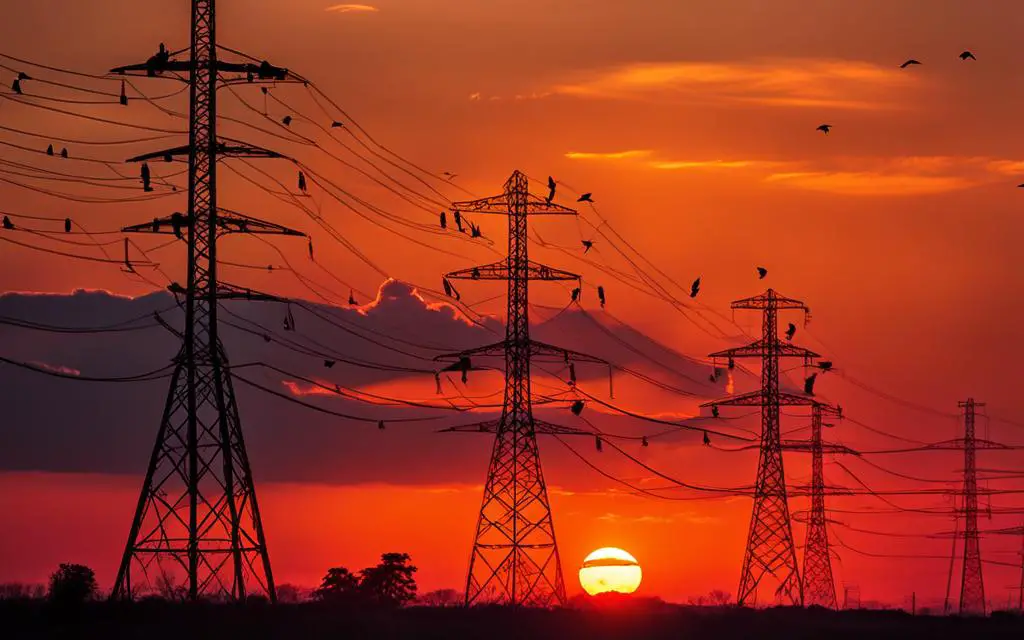
Bird behavior is a fascinating subject, and one common phenomenon that many of us have observed is birds gathering on power lines at dusk. But have you ever wondered why they do this? Let’s explore the reasons behind this intriguing behavior!
Bird flocking and roosting on power lines is a natural occurrence. Power lines provide a convenient place for birds to perch, especially when there are no tall trees or vegetation around. They find power lines attractive for resting, roosting, and hunting. It also offers them a vantage point to observe their surroundings and communicate with each other.
This behavior is not limited to a particular bird species; rather, various types of birds gather on power lines at dusk. Some commonly observed species include starlings, grackles, swallows, crows, pigeons, and sparrows.
The next time you spot birds perched on power lines at dusk, take a moment to appreciate this fascinating display of bird behavior. In the following sections of this article, we will delve deeper into the safety measures for birds on power lines, the species commonly found on them, and the reasons behind their gathering.
Birds perched on power lines are provided with a safe habitat away from ground predators such as cats and coyotes. The elevated position of power lines also offers birds of prey like hawks and shrikes an advantageous vantage point to spot potential prey on the ground below. This strategic advantage enables them to efficiently hunt and feed.
However, there are potential hazards associated with power lines that birds need to be cautious of. Birds can be at risk of electrocution if they touch two power lines simultaneously or make physical contact with another bird on a different wire. These incidents can result in fatal accidents.
To mitigate these risks and protect bird populations, efforts have been made to enhance electricity safety on power lines. One approach is increasing the space between wires, reducing the chances of birds coming into simultaneous contact with multiple lines. Additionally, nesting platforms have been installed near power lines to provide alternative roosting and nesting sites, away from potentially hazardous areas.
“Providing safe habitats for birds on power lines is crucial in maintaining a healthy avian population while ensuring their protection from potential dangers associated with electricity.”
| Methods to Enhance Bird Safety on Power Lines | Benefits |
|---|---|
| Increase space between wires | Reduces the likelihood of simultaneous contact |
| Install nesting platforms | Provides alternative roosting and nesting sites away from hazardous areas |
By implementing these safety measures, we can create a harmonious coexistence between bird populations and power line infrastructure, while minimizing the risk of bird fatalities due to electrocution and other accidents.
A variety of bird species can be found perching on power lines. Common ones include starlings, grackles, swallows, crows, pigeons, and sparrows. Larger bird species like hawks and eagles are more likely to perch on the utility pole rather than the wire. Waterbirds, such as geese and herons, are less likely to sit on power lines. Birds that rely on stealth and surprise for hunting, like sharp-shinned hawks, also tend to avoid power lines.
| Bird Species | Perching Habit |
|---|---|
| Starlings | Often perch on power lines in large flocks. |
| Grackles | Can be frequently seen perching on power lines along with starlings. |
| Swallows | Commonly rest and perch on power lines during migration. |
| Crows | Prefer utility poles for perching instead of the wires. |
| Pigeons | Often seen sitting on power lines in urban areas. |
| Sparrows | Use power lines as resting spots and to scope out food sources. |
While these bird species are commonly observed perching on power lines, it’s important to note that each species has its own preferences and behavior when it comes to choosing perching locations. Some birds may avoid power lines altogether for various reasons, such as hunting strategies or habitat preferences.
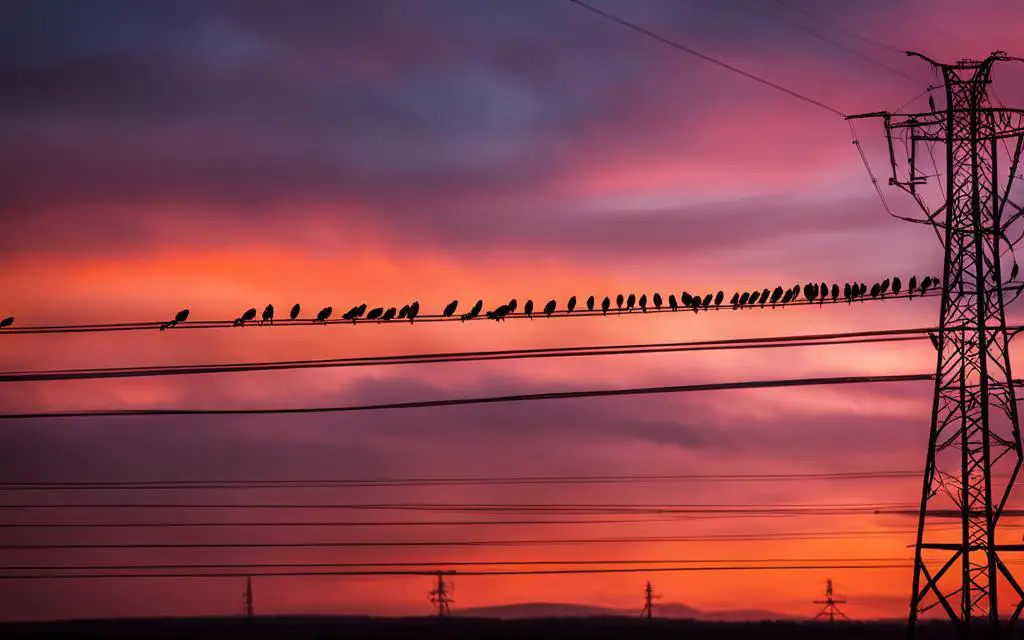
Birds gather on power lines at dusk for various reasons. It is a common phenomenon observed in avian behavior. Let’s explore the factors that contribute to this intriguing behavior.
Power lines provide birds with an advantageous vantage point. When perched on power lines, birds have a clear view of their surroundings, allowing them to spot potential predators or prey. This elevated position also offers a sense of safety, as it keeps them out of reach from ground-based predators like cats or coyotes.
Another reason birds gather on power lines is communal roosting. Birds prefer to roost together in large groups, providing them with warmth and security. Power lines offer a convenient platform for communal roosting, as they provide ample space for multiple birds to safely perch together. Furthermore, gathering on power lines allows birds to engage in social interaction, such as chirping, squawking, and other vocalizations that facilitate communication within the flock.
Power lines offer a thermal advantage for birds. As the sun sets and temperatures begin to drop, power lines retain residual heat, providing a slightly warmer roosting spot compared to open spaces. This thermal benefit attracts birds, especially during colder seasons. Additionally, power lines act as ideal hunting grounds for insects. The warmth radiating from the lines attracts insects, which in turn attracts insect-eating birds. This creates a mutually beneficial arrangement where birds find a steady source of food while helping to control insect populations.
Overall, the phenomenon of birds gathering on power lines at dusk is a fascinating display of avian behavior. It combines the elements of vantage point observation, communal roosting, thermal advantage, and insect hunting, all enhanced by social interactions within the flock.
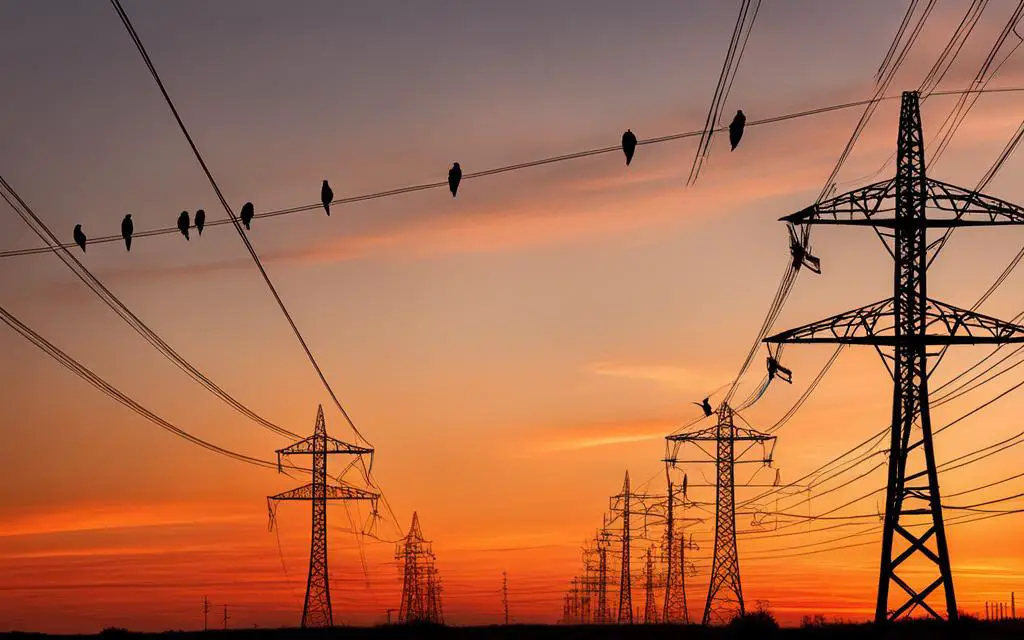
| Reasons Birds Gather on Power Lines | |
|---|---|
| Vantage Point | Observe surroundings and spot predators or prey |
| Safety | Protection from ground predators |
| Communal Roosting | Offer warmth and security in larger groups |
| Social Interaction | Facilitate communication within the flock |
| Thermal Advantage | Retain residual heat, providing warmth |
| Insect Hunting | Attract insects, creating a feeding opportunity |
Birds on power lines engage in various activities that contribute to their survival and adaptation in their environment.
Communication plays a crucial role in the lives of birds perched on power lines. They use a variety of vocalizations to convey messages, establish territory boundaries, and alert each other to potential dangers. Squawking, chirping, and other bird noises fill the air as they interact with one another, forming a complex web of communication.
Power lines provide a reliable navigational aid for birds. They act as landmarks, helping birds orient themselves and find their way during migration or when exploring their territory. The linear structure of power lines acts as a visual cue that assists birds in maintaining their chosen path and reaching their desired destination.
The artificial light provided by power lines can serve as a beacon for birds, attracting them to these structures. Birds are naturally drawn to light sources, especially during dusk and dawn when their activity levels increase. Power lines with their illuminated surroundings can facilitate foraging for food and provide a sense of security by enhancing visibility and reducing the risk of surprise attacks from predators.
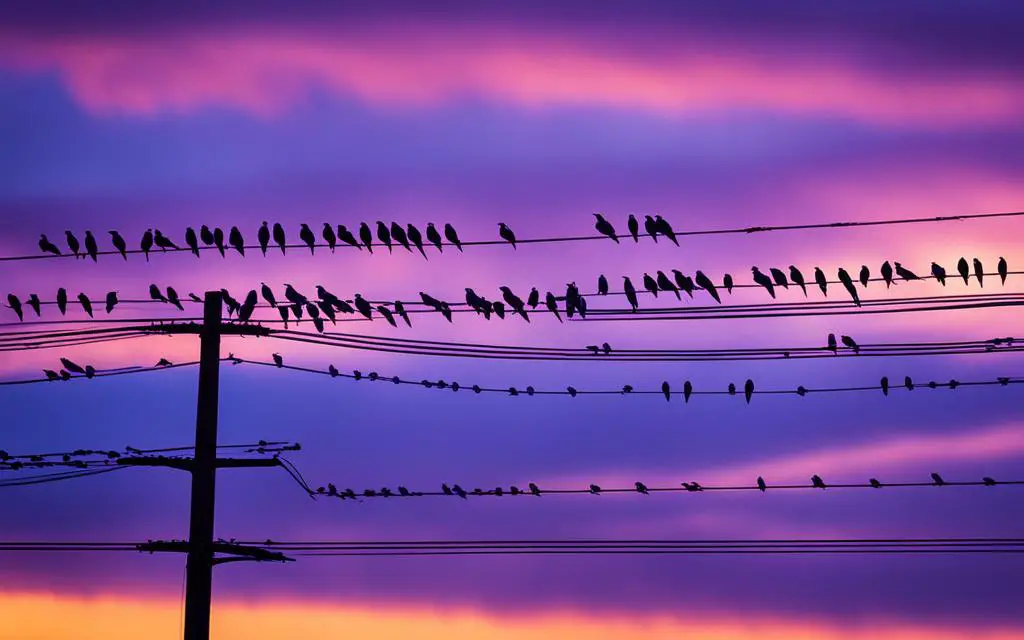
Power lines inadvertently create an artificial habitat that supports bird populations in urban areas. As natural habitats continue to diminish, power lines offer birds a substitute perching and resting spot. They adapt to these new environments and successfully utilize power lines as platforms for nesting, roosting, and observing their surroundings.
| Bird Activity | Description |
|---|---|
| Communication | Birds use vocalizations to communicate, establish territory boundaries, and alert each other to potential dangers. |
| Navigation | Power lines serve as landmarks, helping birds navigate during migration and within their territories. |
| Light Attraction | The artificial light provided by power lines attracts birds, aiding in foraging and reducing predator risks. |
| Artificial Habitat | Power lines offer birds a substitute habitat for nesting, roosting, and observing their surroundings. |
Here at ElectroSafe, we understand the importance of ensuring bird safety on power lines. We have implemented various measures to protect our feathered friends from the risk of electrocution and minimize bird mortality. Our conservation efforts aim to strike a balance between electricity safety and the preservation of wildlife.
To prevent bird fatalities, we have taken steps to increase the distance between wires and cover exposed energized parts. By maintaining adequate spacing between power lines, we create a safer environment for birds to perch without the risk of accidental contact. Moreover, our diligent inspection and maintenance routines help identify and rectify any potential electrical hazards promptly.
To discourage nesting on power line infrastructure, we have introduced nesting platforms. These specially designed structures provide an alternative nesting site for birds, reducing the likelihood of them building nests on potentially hazardous wires. The installation of these platforms not only ensures bird safety but also contributes to maintaining a reliable electricity supply.
Our commitment to conservation concerns drives us to go beyond basic safety measures. We actively collaborate with environmental organizations and researchers to develop innovative solutions to reduce bird mortality on power lines. Through ongoing research and analysis, we strive to implement meaningful changes that have a positive impact on avian populations.
“Conservation encompasses the delicate balance between human activities and the preservation of nature. By taking a holistic approach to bird safety on power lines, we can protect these beautiful creatures while satisfying our need for electricity. It’s a win-win situation that promotes harmony between humans and wildlife.”
At ElectroSafe, we believe that responsible electricity management goes hand in hand with bird conservation. Our ongoing efforts to enhance bird safety measures on power lines reflect our commitment to environmental stewardship. By prioritizing the well-being of birds, we contribute to the protection of our natural ecosystems and promote a sustainable future for all.
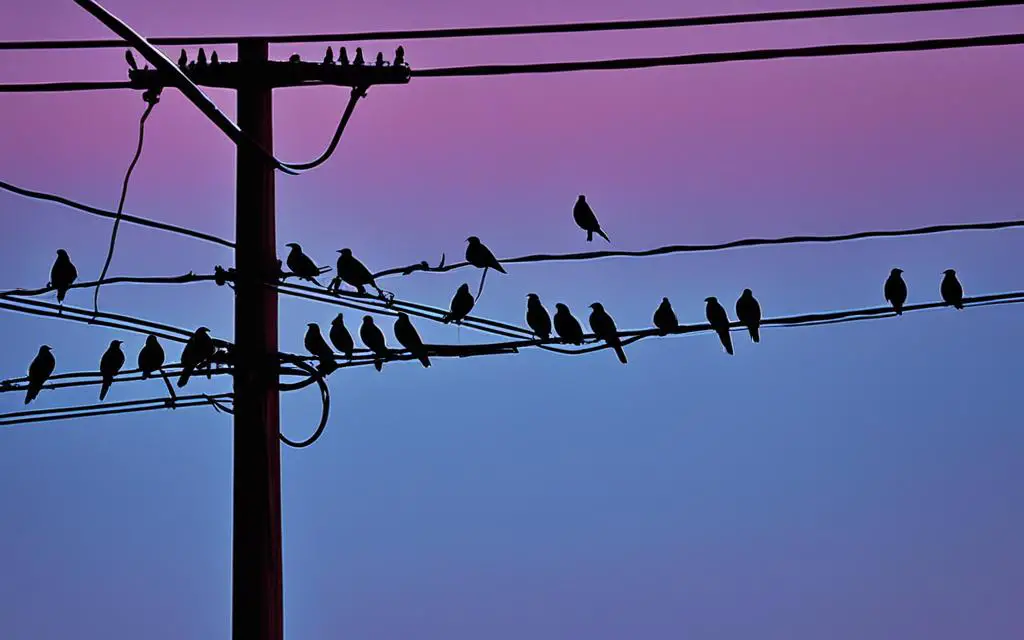
The presence of birds perched on power lines has inspired a rich tapestry of art and literature throughout history. The image of birds on power lines often carries symbolic meanings that resonate with different individuals and cultures. For some, it symbolizes freedom, as birds have the ability to soar through the skies, unrestricted by earthly constraints.
Artists and authors have drawn inspiration from the sight of birds on power lines, weaving their symbolism into creative works that evoke a range of emotions and interpretations. It serves as a powerful metaphor for resilience, adaptability, and transcending boundaries.
“Like birds on power lines, we find strength in unity and support. Together, we rise above adversity, embracing our shared experiences and celebrating our individuality.”
The mesmerizing image of birds perched on power lines has been captured by photographers and immortalized in paintings, sculptures, and poetry, further amplifying the enchantment and allure of these avian creatures. Through different artistic mediums, these depictions express the beauty and mystery of birds’ connection to power lines, inviting us to reflect on our own relationship with the world around us.
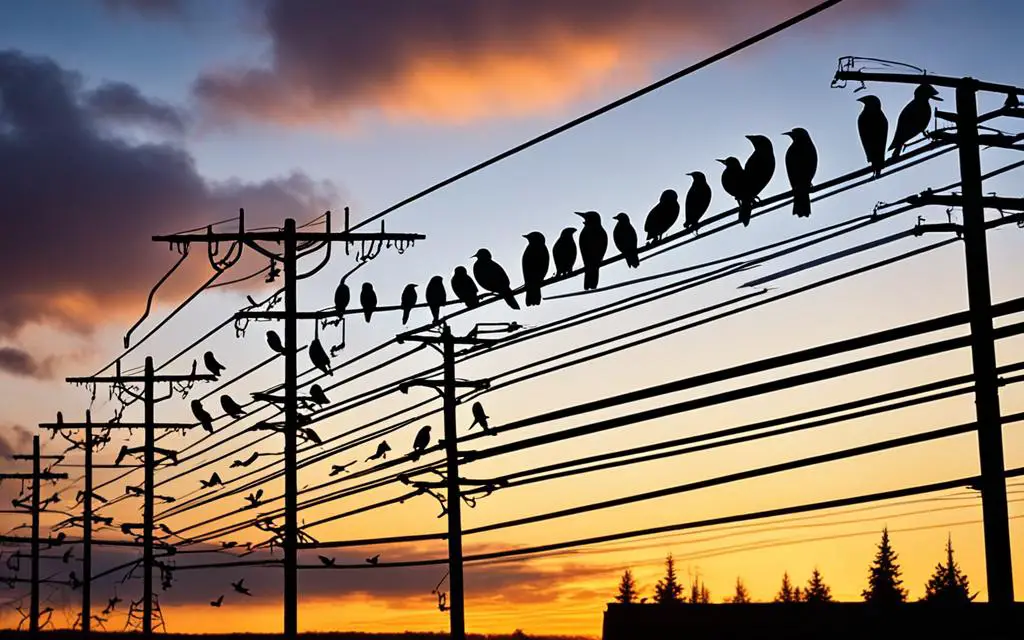
| Artwork | Artist | Medium |
|---|---|---|
| “Flight of Freedom” | Emily Davidson | Oil on canvas |
| “A Song Unheard” | Sebastian Moore | Sculpture (Bronze) |
| “Lines of Eternity” | Isabella Thompson | Photography |
Birds exhibit fascinating behaviors at dusk, especially during migration. As the sun begins to set, bird activity increases, and specific behaviors come to the forefront. Flocking and roosting activities become more prominent as birds gather in large numbers, creating a captivating sight.
During dusk, birds often converge at intersections where there is an abundance of both natural and artificial light. This phenomenon allows them to navigate their surroundings and communicate with each other effectively. The combination of these behaviors creates a dynamic and active environment filled with the sounds of chirping and squawking.
These behaviors are deeply rooted in avian instincts and have a purpose beyond the visual spectacle. Birds use this time to prepare for the night ahead. They communicate important information to one another, such as finding suitable roosting spots and ensuring safety from predators.
The dusk phenomenon is closely linked to bird migration patterns. Many species take advantage of the fading light to gather in large numbers before embarking on their journey. This behavior allows them to benefit from the safety and social interaction provided by group formation.
“At dusk, the skies come alive with the intricate dance of birds as they prepare for their nocturnal activities.” – John James, Birdwatcher
| Bird Behavior at Dusk | Description |
|---|---|
| Flocking | Birds gather in large numbers, creating impressive formations in the sky. |
| Roosting | Birds find suitable places to rest and prepare for the night, ensuring safety in numbers. |
| Communication | Birds use vocalizations to share information, find roosting spots, and maintain social bonds. |
| Migration Preparation | Many species gather in flocks as a precursor to their migratory journeys. |
Birds often roost on power lines, especially larger species like crows, ravens, and vultures. Power line wires are not suitable for nesting, but birds utilize utility poles and other infrastructure for nesting purposes. This adaptation has allowed some bird species to thrive in areas without trees. Power line ecology plays a role in supporting urban wildlife populations.
Power lines provide an elevated and relatively safe platform for birds to rest and sleep. Roosting on power lines allows birds to stay above ground level, out of reach of predators like cats and coyotes. The high vantage point and lack of dense vegetation on power lines also provide birds with easier mobility and better visibility to spot potential threats or food sources.
While power line wires are not ideal for nesting due to their slender structure, birds have found alternative nesting sites on utility poles, transformers, and other parts of the power line infrastructure. These areas offer shelter and protection for nesting birds, enabling them to successfully raise their young.
This image shows a bird nest on a power line, demonstrating the adaptability of birds to urban environments.
Power line ecology has had an impact on urban wildlife populations. By providing suitable roosting and nesting sites, power lines support the survival and reproduction of bird species in areas where traditional nesting habitats, such as trees, may be limited or nonexistent. The presence of birds on power lines contributes to the diverse array of wildlife thriving in urban environments.
For bird-watching enthusiasts, observing birds on power lines presents a wonderful opportunity to witness these fascinating creatures in action. Whether you’re an avid birdwatcher or someone looking to explore a new hobby, there are plenty of resources available to enhance your bird-watching experience.
When it comes to educational materials, you’ll find a wealth of online and offline resources that delve into the world of avian behavior. From books and field guides to educational websites and online courses, these educational resources provide valuable insights into birds and their behaviors. By expanding your knowledge, you can better understand the species you encounter on power lines and appreciate their unique characteristics.
Additionally, joining local birdwatching groups can further enhance your bird-watching adventures. These groups often organize outings and bird-watching excursions, allowing you to explore various habitats and observe birds in their natural environments. Not only do these groups provide a platform for sharing knowledge and experiences, but they also foster a sense of community among bird enthusiasts.
Citizen science projects offer another exciting way to contribute to bird research while engaging in bird-watching. These projects involve collecting data or participating in scientific observations, contributing vital information to ongoing scientific studies. By participating in citizen science projects, you become an active contributor to the scientific community and help conserve bird populations.
| Organization | Location | Contact Information |
|---|---|---|
| National Audubon Society | United States | www.audubon.org |
| Royal Society for the Protection of Birds (RSPB) | United Kingdom | www.rspb.org.uk |
| Birdlife International | Global | www.birdlife.org |
In addition to observing birds, many bird-watching enthusiasts also engage in wildlife photography. Capturing stunning images of birds perched on power lines allows you to preserve their beauty and share it with others. Learn photography techniques specific to bird photography to capture the perfect shot and showcase the remarkable avian diversity found on power lines.
By taking advantage of the educational resources, joining local birdwatching groups, participating in citizen science projects, and exploring wildlife photography, you can immerse yourself in the world of urban bird-watching. So grab your binoculars, camera, and enthusiasm, and embark on an exciting journey to discover the wonders of birds on power lines.
Birds gather on power lines at dusk for various reasons, including safety, convenience, communication, and foraging opportunities. Power lines have become an integral part of bird behavior and habitat, enabling them to adapt to urban environments. Birds find power lines to be safe perching spots, protecting them from ground predators and offering a vantage point for observing their surroundings.
Efforts have been made to protect birds from electrocution on power lines through measures such as increasing the distance between wires and installing nesting platforms. The presence of birds on power lines has also inspired artistic expressions and creative works in various forms of art and literature.
For bird enthusiasts, observing and studying bird behavior on power lines provide exciting bird-watching opportunities. Educational resources, local birdwatching groups, and citizen science projects are available for those interested in learning more about avian behavior and contributing to bird conservation efforts. So, the next time you spot birds on power lines, take a moment to appreciate their adaptability and the fascinating behaviors they exhibit.
Birds gather on power lines at dusk for various reasons, including safety, convenience, communication, and foraging opportunities.
When birds gather on power lines, it signifies their instinctual behavior of flocking or roosting, providing them with a vantage point to observe their surroundings and communicate with each other.
Power lines are a convenient perch for birds, especially when there are no tall trees or vegetation nearby. They offer a safe location away from ground predators and provide a thermal advantage for insect hunting.
Birds perched on power lines are safe from ground predators, but they can get shocked if they touch two power lines or make physical contact with another bird on a different wire. Efforts have been made to protect birds from electrocution on power lines, such as increasing the space between wires and installing nesting platforms.
Common bird species that can be found perching on power lines include starlings, grackles, swallows, crows, pigeons, and sparrows. Larger bird species, like hawks and eagles, are more likely to perch on the utility pole rather than on the wire.
Birds gather on power lines at dusk because it is common for flocks of birds to land on power lines when there are no other perches available nearby. They use this time to observe their surroundings, communicate with each other, and prepare for the night.
Birds communicate and interact with each other on power lines through squawking, chirping, or making noises. Power lines provide a communal roosting area where birds can socialize, interact, and establish hierarchies.
Power lines act as an artificial habitat for birds by providing perching and roosting opportunities in areas without tall trees or vegetation. They also attract insects due to artificial light, which helps birds forage for food.
Efforts have been made to protect birds from electrocution on power lines by increasing the space between wires and covering exposed energized parts. Installing nesting platforms also discourages birds from nesting directly on power line infrastructure.
The image of birds on power lines carries symbolic meanings in art and literature. It can symbolize freedom for some and has inspired artistic expressions and creative works by many artists and authors.
Yes, birds exhibit specific behaviors at dusk, especially during migration. Flocking and roosting activities become more prominent during this time, as birds gather in large numbers at intersections with lots of real and artificial light.
While power line wires are not suitable for nesting, birds utilize utility poles and other infrastructure for nesting purposes. This adaptation has allowed some bird species to thrive in areas without trees, contributing to power line ecology.
Absolutely! There are educational resources, local birdwatching groups, and citizen science projects that focus on studying birds and their behaviors. Bird photography is also popular among wildlife photographers who capture captivating images of birds perched on power lines.

My name is Shane Warren, the author behind Your Bird Buddy – your ultimate guide to the wonderful world of birds! Unleash your inner avian explorer as we delve into a vibrant library of knowledge dedicated to all things feathered. From learning about diverse bird species from across the globe to understanding their captivating habitats and behaviors, I’m here to fuel your passion for these magnificent creatures. Not only that, but I also provide valuable insights on being a responsible and informed pet bird owner. Join our vibrant community and let’s celebrate the feathered wonders of the world together – one chirp at a time. And be sure to join our Your Bird Buddy Community over on Facebook!